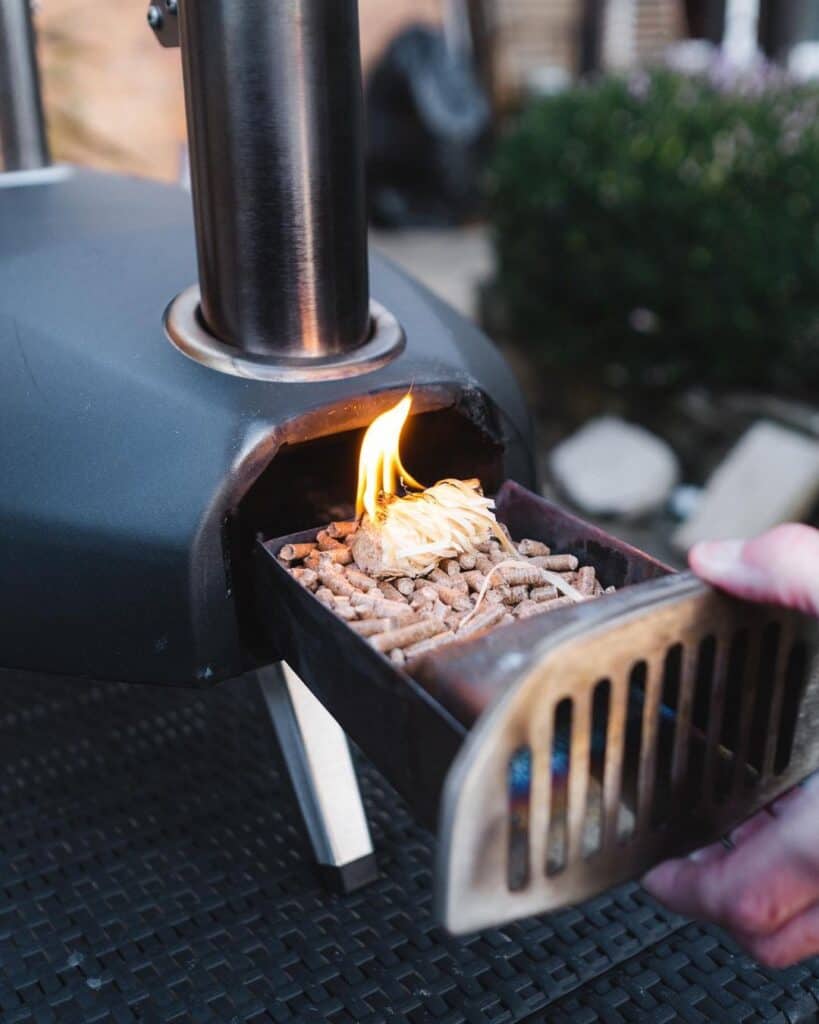One of the more interesting trends that I’ve seen develop over the past year is the explosion of at-home cooking and homemade pizza. The Ooni oven is a small, lightweight woodfire oven that’s designed to create a taste that’s remarkably similar to going out to eat at one of those fancy Italian pizzerias.
If you’ve recently purchased your Ooni oven, you’re probably wondering what the best wood for it is…
The best wood for an Ooni Oven is the cooking logs made by Smoak Firewood. All of their wood is 100% free from preservatives, kiln-dried for maximum burning, and they offer the wood in five different varieties (white/red oak, maple, hickory, and cherry).
If you’re looking for super high-quality wood that’s guaranteed to help you bake a great pizza, then you can’t go wrong with it!

In today’s article, I’m going to break down the flavor profile that you can expect from each type of wood offered by Smoak Firewood. Then, I’m going to explain the difference between “cooking wood” and traditional firewood that you use in your backyard. I’ll also answer a couple of other common questions regarding what you can and can’t use inside of your new Ooni oven.
Choosing The Best Wood For Your Ooni Oven
When restaurants and pizzerias closed during the pandemic, a lot of us were left without our favorite foods and snacks, leaving us only two options; pay tons of money ordering out or making it ourselves!
Personally, I decided to fine-tune my pizza baking skills. I’ve always enjoyed cooking for myself, but up until the pandemic it had always been a once-in-a-while thing that I did whenever I was bored or had a day off. These days, I’d wager that I cook around 80% of my own meals.
Ultimately, I feel healthier because of it. I know exactly what I’m eating and I can make my food exactly as I see fit without having to feel awkward about asking a waiter to add or remove a certain ingredient.
As part of my quest to become a better pizza chef, I purchased an Ooni oven last year, along with several other accessories including a pizza stone, and a large metal pizza peel. While they aren’t necessary, I can attest to the fact that they can bake a phenomenal pizza (and they’re tons of fun too).
Part of cooking with a woodfire pizza oven is choosing the right cooking wood for your oven. You definitely don’t want to just use any old wood you find lying around (I’ll explain below), so it’s vital to find a reliable source. I’ve found that Smoak’s cooking firewood produces the best results compared to anything else I’ve used so far. It is a bit expensive for everyday use, but I only ever use it to bake pizzas once or twice a week, so it doesn’t bother me.

Smoak offers several different varieties of wood. Each different type will give the pizza a uniquely different “smoky” flavor. Although the difference is subtle, it’s definitely noticeable. Here is what you can expect from each type.
White Oak
White oak is the same wood that’s used to make the barrels where bourbon is aged in. The tree is known for producing a light, slightly sweet flavor with hints of vanilla and spice. It’s a great all-around wood that’s great for a Neapolitan-style pizza.
Red Oak
Red oak is known for burning extra hot, so it’s a great choice if you’re cooking a thicker pizza like a deep dish or a meat-lovers stacked with thick chunks of meat. It produces a slightly stronger mesquite/smoky flavor than white oak does.
Maple
Maple has a wonderfully light and sweet flavor. It’s an excellent choice for thin-crust pizzas like a Margherita-style pizza or for any pizza that uses white meat like chicken or turkey.
Hickory
If you eat bacon, then hickory is probably something that you’ve tasted before (as many bacon companies offer hickory-smoked bacon). It burns at a medium temperature, produces mild smoke, and has a spicy, tangy flavor.
Cherry
If you want to change things up a bit and add an extra hint of fruitiness to your pizza, then I definitely recommend trying cherry wood. It pairs especially well with a good supreme pizza that’s heavy on the veggies or a pineapple pizza (don’t come at me with the hate).
Can I Use Any Wood For My Ooni Oven?

It’s important to use cooking wood for your woodfire oven because it’s the only real way to guarantee that your wood is clean (no dangerous chemicals, cleaners, or pesticides) and dry (wet/damp wood burns horribly). While it does cost a bit more than grabbing sticks out of your backyard, it’s worth it.
Can I Use Woodchips or Pellets For My Ooni Oven?
If you’re just cooking a smaller appetizer or a really thin-crust pizza, then you can get away with using wood smoking chips or pellets in your Ooni oven. However, these smaller chips burn at a lower temperature, meaning that it will take longer for a big pizza to cook.
What Is The Difference Between Firewood And Cooking Wood?
At this point, you may be wondering if you can use firewood with your Ooni oven. Again, the answer is no. While good old-fashioned firewood is dry, it’s also full of sap. The sap is great for keeping the bonfire burning, but it’s toxic to eat/inhale and will add a very bitter taste to your pizza. Last but not least, the sap can be a major pain in the behind to clean off of your pizza stone.
Can I Use Charcoal For My Ooni Oven?
If you have nothing else, then you can get away with using clean-burning charcoal in your woodfire oven. However, I wouldn’t recommend it as it will give your pizza an odd “hamburger flavor.” The thick, black residue that it leaves inside your oven is also a lot harder to get rid of than traditional cooking wood smoke.